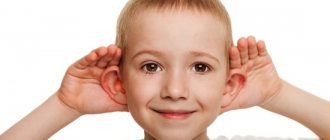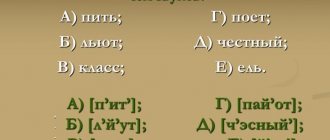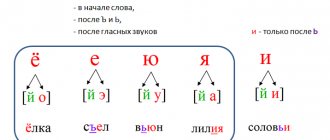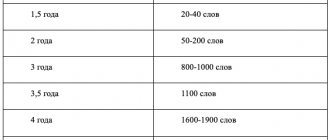Almost all parents experience childhood speech disorders. Only a rare few manage to avoid certain problems that arise when children learn their native language. The most common difficulties arise, of course, with sounds. Not everyone can immediately pronounce all consonants correctly and clearly.
But it’s not just pronunciation that worries parents and teachers. How clearly a child speaks depends not only on the ability to pronounce “devious” sounds, but also on the important ability to distinguish between them. The correctness of speech directly depends on whether your son or daughter was born with sensitive hearing. Of course, we are not talking about physiological hearing ability or musical ability. The ability to catch individual, even short, elements of speech is called phonemic awareness, and this is what we will talk about.
What is phonetic hearing
Anyone who has visited a speech therapist at least once or performed speech therapy tasks with a child is familiar with this concept; specialists use it constantly. Most likely, you have already heard about its importance for speech development. What does it mean and why does it affect the way your baby speaks? Experts believe that phonemic hearing is a person’s ability to distinguish individual phonemes, i.e. sounds. This skill represents the skills:
- recognition;
- comparisons;
- repetition of the elements that make up words.
It is a unique and necessary feature that complements the normal ability to hear.
In young children, a speech therapist checks, first of all, normal hearing - the reaction to everyday noises (ringing, humming, whistling). If it is in order, then the ability to distinguish more subtle components of the surrounding world of sounds is gradually formed.
Next comes the ability not only to isolate the phonemes of a language, but also to reproduce them. This phenomenon can be compared to manually tuning a radio or walkie-talkie. In a sea of noise, speech hearing helps you catch words and gradually understand them by hearing them clearly. A similar process occurs in every child; he gradually “tunes in” to the speech of adults, catching it better and more accurately. (Of course, this process is much worse for hearing-impaired children.)
If this does not happen, then the child’s phonemic hearing and phonemic perception are impaired. They are the ones who influence how accurately your son or daughter is able to repeat a particular word. Sounds individually may sound perfect, but together they “don’t sound like friends.” For example, instead of “kolobok” you will hear “kobolek”, instead of “shop” - “zigizin”, instead of “tram” - “tranvay”, etc.
For a child, this state of affairs is the age norm, but if such features persist after two years, then you should seek help from a speech therapist and start classes as soon as possible.
A child with such problems not only finds it difficult to express his thoughts, but it is difficult for others to understand him. He lags significantly behind his peers; speech underdevelopment makes it difficult for him to communicate with them. At an older age, if measures are not taken to correct speech hearing impairments, the student will make many mistakes when writing and study worse.
The task of parents is to notice the presence of such characteristics in their child as early as possible and take the necessary measures.
Timely assistance from a specialist will help correct the situation. There are a huge number of games, tasks, exercises aimed at developing phonemic awareness in children, as well as training phonemic perception. These two concepts are often found in conjunction, so it’s worth taking a closer look at the second component of this pair.
Phonemic hearing and phonemic awareness
Phonetic perception is one of the components of phonemic hearing, which is the ability to determine the sound structure of a word, its syllabic “skeleton”. This skill is necessary for the child to be able to analyze his own speech, “adjusting” it to the “adult” version. This is a complex process that takes place in several stages:
- The child learns to determine the presence of a particular sound in a word. If you ask him to highlight the first sound with his voice, he will be able to do it. He also becomes able to name several words beginning with a certain vowel.
- Then he manages to recognize the extreme sounds in a word. It is easier to determine the latter, but gradually the former can also be analyzed.
- Afterwards, the ability to pronounce a word by sounds is formed. At first, this exercise can be performed only with short words, but with age the skill improves.
- Last of all, the ability to find the place of sound among neighboring ones appears. This suggests that phonetic perception has been formed.
The baby can master the first two stages on his own, but the subsequent ones - only with the help of teachers, during special exercises. If targeted training sessions are not carried out to train phonemic perception and phonemic hearing, the child will experience difficulties in mastering spoken and written speech.
Literacy learning is based on sound analysis, so phonemic awareness also plays a big role in the process of learning to read. Teachers, speech therapists, and parents are involved in its improvement, but the foundations of this ability are laid from the first days of the baby’s life.
Language is a means of communication between people due to its material sound nature. Mastering the sound system of speech is the basis on which mastery of language as the main means of communication is built.
The acquisition of the sound side of a language includes two interrelated processes: the process of development of the pronunciation side of speech and the process of development of the perception of speech sounds.
A child’s early understanding of words and phrases spoken by an adult is based not on the perception of their sound composition, but on capturing the general rhythmic and melodic structure of the word or phrase. The word at this stage is perceived by the child as a single undivided sound, having a certain rhythmic and melodic structure. The period of prephonemic speech development lasts up to one year, then is replaced by a period of phonemic speech development.
The immaturity of phonemic hearing in children entails difficulties in the formation of phonemic perception, without which it is impossible to develop its highest level - sound analysis, mental separation into component elements (phonemes) of different sound combinations: sounds, syllables, words, which will subsequently cause reading and writing disorders .
The difference between phonemic awareness and sound analysis is as follows:
- phonemic awareness does not require special training, but sound analysis does;
- phonemic perception, which is based on phonemic hearing, is the first step in the progressive movement towards mastering literacy, sound analysis is the second.
Another important factor: phonemic perception is formed in the period from one year to 4-5 years, sound analysis - after 4-5 years.
And finally, phonemic awareness is the ability to distinguish the features and order of sounds in order to reproduce them orally, sound analysis is the ability to distinguish the same in order to reproduce sounds in written form.
Thus, phonemic awareness is a fundamental component of competent writing and reading.
Phonemic hearing is a subtle, systematized hearing that allows you to distinguish and recognize the phonemes of your native language that make up the sound shell of a word. Phonemic hearing, being part of physiological hearing, develops from birth to 5 years and is the basis for understanding the speech of another person, controlling one’s own speech, and writing competently in the future.
L.S. Vygotsky coined the term “phonemic hearing ,” which included 3 speech operations:
- the ability to hear whether a given sound is in a word or not;
- the ability to distinguish words that contain the same phonemes arranged in different sequences;
- the ability to distinguish words that sound similar but have different meanings.
Signs of phonemic hearing disorders:
- violations of sound pronunciation (replacement and mixing of sounds);
- violations of the sound structure of a word, which manifest themselves in errors in sound analysis (omission of vowels and consonants, syllables; insertions of letters; rearrangements of letters, syllables);
- disturbances in the differentiation of sounds by ear that have acoustic-articulatory similarities, manifested in the replacement and mixing of sounds, and in writing in the mixing of letters.
D.B. Elkonin introduced the term “phonemic perception,” which means the ability to distinguish individual sounds of speech by ear and determine the sound composition of a word. How many syllables are in the word MAC? How many sounds does it have? What consonant sound comes at the end of a word? What is the vowel sound in the middle of a word? While searching for the most effective method of teaching children to read and write, he noticed that phonemic awareness alone is not enough to master these skills.
Children need to be specially trained in phonemic awareness, which includes 3 operations:
- the ability to determine the linear sequence of sounds in a word;
- the ability to determine the position of a sound in a word in relation to its beginning, middle or end;
- awareness or counting of the number of sounds in a word.
Unformed phonemic perception, on the one hand, negatively affects the development of children's sound pronunciation, on the other hand, it makes it difficult to master syllabic and sound-letter analysis, without which full reading and writing are impossible.
If you have any concerns about your child’s lack of development of phonemic perception, you should first check the child’s physical hearing. After making sure that it is not reduced, you can move on to correcting phonemic perception.
The development of phonemic processes includes:
- development of the ability to hear a sound and distinguish it from other sounds, syllables, words;
- developing the ability to divide words into sounds;
- developing the ability to combine individual sounds into syllables and words;
- development of the ability to compare words that differ in one sound.
In the work on the formation of phonemic perception, the following stages can be distinguished:
Stage I – recognition and discrimination of non-speech sounds.
The auditory discrimination of non-speech sounds is the basis for the development of phonemic hearing.
Game "Guess what sounded." Listen carefully with your child to the sound of water, the rustle of a newspaper, the clinking of spoons, the creaking of a door and other everyday sounds. Invite your child to close his eyes and guess what it sounded like? Game "Blind Man's Bluff". The child is blindfolded and moves towards the ringing bell, tambourine, or whistle.
Game "Let's Clap" The child repeats the rhythmic clapping pattern. For example, two claps, pause, one clap, pause, two claps. In a more complicated version, the baby repeats the rhythm with his eyes closed.
Stage II - distinguishing the height, strength, timbre of the voice on the material of identical sounds, words, phrases.
Game "Find out your voice." Record on tape the voices of loved ones and the voice of the child himself. Ask him to guess who is speaking. Game "Three Bears". The child guesses which character in the fairy tale the adult speaks for. A more complex option - the child himself speaks for the three bears, changing the pitch of his voice.
Stage III – distinguishing words that are similar in their sound composition.
Game "Listen and choose". In front of the child are pictures with similar-sounding words ( com, catfish, crowbar, house ). The adult names the object, and the child picks up the corresponding picture.
Game "True or False". The adult shows the child a picture and names the object, replacing the first sound (forota, korota, gate, morota). The child claps his hands when he hears the correct pronunciation.
Stage IV - differentiation of syllables.
Game "Clapping". The adult explains to the child that there are short and long words. He pronounces them, dividing them into syllables intonationally. Together with the child he pronounces words (pa-pa, lo-pa-ta, ba-le-ri-na), clapping the syllables. A more complex option is for the child to independently indicate the number of syllables in a word.
Game "What's extra?" An adult pronounces a series of syllables “pa-pa-pa-ba-pa”, “fa-fa-wa-fa-fa”. The child claps when he hears an “extra” syllable.
Stage V – differentiation of phonemes.
You should definitely start with differentiating vowel sounds. Explain to the child that words are made up of sounds, and play sounds with him: Children are given pictures depicting a train, a girl, a bird... and explain: “The train is buzzing ooo; the girl is crying ahh; the bird sings; the mosquito rings - zzzz, the wind blows - ssss.” Next, the adult pronounces the sound for a long time, and the children pick up the corresponding pictures, guessing who (what) makes it.
Game "Raise your hand". The adult pronounces a series of sounds, and the child raises his hand when he hears the given phoneme. “Which sound do we hear most often? “Senya and Sanya have a catfish with a mustache in their nets.”
Stage VI – development of basic sound analysis skills.
Game "How many sounds". An adult names one, two, three sounds, and the child identifies and names their number by ear. Game "Guess the word." The child is given words with a missing sound - he needs to guess the word. For example, the sound “l” escaped from the words (hundred..., ...ampa, jump...ka).
It is important to take these exercises seriously, devoting enough time and attention to them, while not forgetting that your activities should become attractive and interesting for the child.
Why does a child need good phonemic awareness? This is due to the method of teaching reading existing in schools today, based on the sound analysis of words.
How to develop phonemic hearing in a child? The best way to do this is in the game.
When is the best time to develop phonemic awareness in children? In psychology, there is the concept of sensitive age - this is a period of optimal development of certain aspects of the psyche, during which the developing organism is especially sensitive to certain types of influences. At the age of 4-5 years, children are most susceptible to the development of phonemic awareness.
By paying due attention to the development of phonemic hearing, as the basis for the development of phonemic perception, you will make it easier for your child to master correct sound pronunciation, and in the future, reading and writing.
Behind the apparent simplicity, the process of reading and writing is very complex.
First, the child must isolate the desired sound from the word. Then remember which letter represents this sound. Then imagine what this letter looks like, how its elements are located in space. After which the brain “gives a command” to the hand, which performs the correct movements with a ballpoint pen. At the same time, the student must remember which rule needs to be applied in writing at this moment.
The exercises we presented for the development of sound analysis and synthesis, as the highest stage in the development of phonemic perception, will contribute to the development of literate writing in children.
Exercises to develop phonemic analysis and synthesis
- Determining the number of sounds in a word and their sequence. (How many sounds are in the word “faucet”? Which one is 1, 2, 3, 4?)
- Coming up with words with a certain number of sounds.
- Recognition of words presented to the child in the form of sequentially pronounced sounds (What word will come from these sounds: k-o-t?)
- Formation of new words by “building up” sounds. (Add a sound to the word “mouth” to make a new word? Mole-grot; steam-park)
- Formation of new words by replacing the first sound in a word with some other sound. (House-som-lom-com-Tom).
- Formation of as many words as possible from the sounds of a given word, TRACTOR - cancer, so, from, rock, current, cat, who; company, bark, cake, court.
- Select pictures whose titles contain 4-5 sounds.
- Insert the missing letters into the words: vi.ka, di.an, ut.a, lu.a, b.nt.
- Choose words in which the given sound would be in 1st, 2nd, 3rd place ( sh uba, u sh i, koshka ).
- Compose words of different sound-syllable structures from the letters of the split alphabet: (himself, nose, frame, fur coat, cat, jar, table, wolf).
- Select words with a certain number of sounds from the sentences, name them orally and write them down.
- Add different numbers of sounds to the same syllable to get a word: pa -par, pa -park, pa -sails.
- Find words for each sound. The word is written on a piece of paper. For each letter, choose a word that begins with the corresponding sound. Words are written in a certain sequence: first words with 3 letters, 4, 5, etc.
R U H TO A MOUTH ULYA HOUR CAT ANYA ROSE CORNER BOWL PORRIDGE STORK SLEEVE STREET CASE CRUST ASTER - From of words in such a way that each subsequent word begins with the last sound of the previous word : do m - m ak - cat - apo r - ruka .
- Dice game. When throwing a dice, come up with a word consisting of as many sounds as there are dots on its top face.
- The word is a mystery. Write 1 letter of the word and put dots in place of the remaining letters. If the word is not guessed, the 2nd letter is written, etc.
P ………. (yogurt).
- Write the letter in the box: RA□, KA□A.
These recommendations can be used by speech therapists of educational organizations in classes with primary schoolchildren who have phonemic perception disorders, and by speech pathologists with students in correction classes. Also, they can be used by primary school teachers in the development of sound-letter analysis and synthesis in children in order to prevent dysgraphia and dyslexia.
Literature:
- Efimenkova L.N. Correction of oral and written speech of primary school students. M. Education, 1991
- Efimenkova L.N. Correction of errors caused by immature phonemic perception. Didactic material on correction of written speech. M. Book lover, 2008
- Kozyreva L.M. “Riddles of sounds, letters, syllables.” Notebook for speech therapy classes No. 1, Yaroslavl: Academy of Development, 2006.
- Sadovnikova I.N. Impaired written speech in primary schoolchildren. M.: Education, 1983.
- Tkachenko T.A. Formation of sound analysis and synthesis skills. Album for individual and group lessons with children 4-5 years old. M.: Publishing House GNOM and D, 2005.
- Tkachenko T. A. Speech therapy notebook. Development of phonemic awareness and sound analysis skills. – St. Petersburg: DETSTVO-PRESS, 2000.
- Yastrebova A.V. Correction of speech disorders in secondary school students. M.: Education, 1984.










